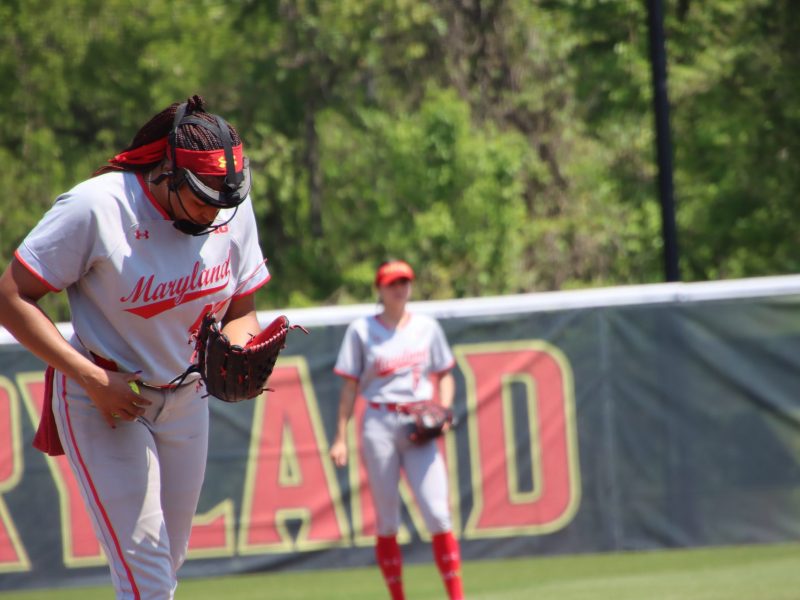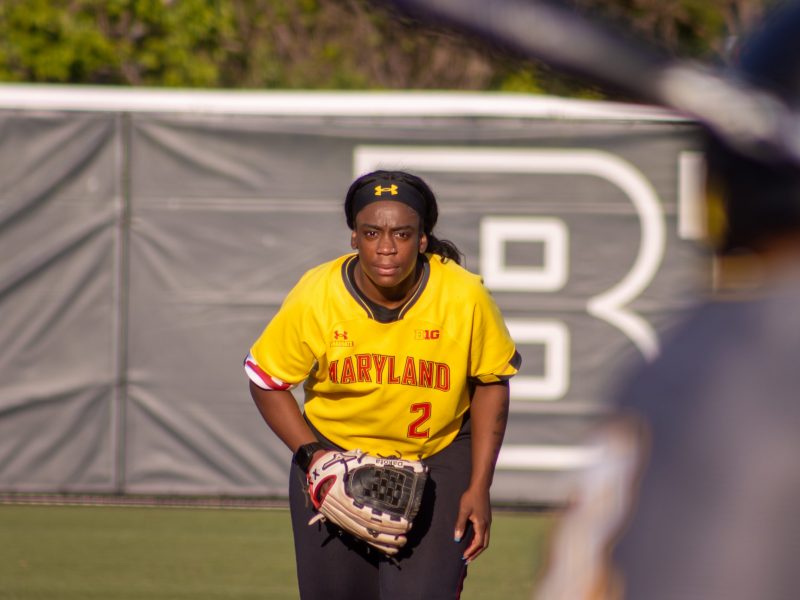The nine-hole pitching pocket has become a staple for baseball and softball coaches. It’s a net with nine pockets that are separated by cords, intended to mimic a strike zone.
Maryland softball pitching coach Laura Heberling has used the net throughout her time with the Terps to help pitchers visualize the strike zone and attack specific spots.
However, for senior ace Courtney Wyche, Heberling wanted to introduce a more difficult challenge. So, the coach decided to innovate. Heberling brought out circular rings with only a six-inch diameter, according to Wyche, and placed them against the backstop.
The diameter of a softball is 3.8 inches, more than half the size of the ring.
Heberling remembered the struggles Wyche had when first introduced to the tactic.
“She was kind of missing [the rings] big,” Heberling said. “When it would be way out of the zone she would just be like, ‘Ugh, why can’t I do that.’”
The senior began to work tirelessly on the drill, emphasizing hitting the spot not only with her fastball but also her off-speed pitches. Heberling eventually started to move the rings higher in the strike zone because of the senior’s prior weaknesses.
In the past, Wyche had been known as a down in the zone pitcher, using her drop-ball below batters knees and trying to get them to chase it. But when examining her stats, she realized that by only utilizing one plane of the strike zone, she was limiting herself on the mound.
“I wanted to change kind of the definition of how I was looked at as a pitcher,” Wyche said.
[Schlotterbeck, Wyche star in Maryland softball’s wins over East Carolina and Saint Joseph’s]
So, Wyche and Heberling set out to develop a pitch that could attack the top of the strike zone with both command and spin. High velocity is a part of Wyche’s arsenal, and the two wanted to find a pitch that changed a hitter’s eye level during an at-bat.
A pitch at the top of the zone that has a high spin rate is a much more difficult pitch to hit. Knowing this, Wyche worked on a pitch she felt could surprise hitters and complement her other pitches.
What she found was a high curveball that had not only the side movement pitchers value, but the rising movement that attacked the top plane of the zone.
Wyche said having a high pitch in her arsenal has forced hitters to see a different plane of the strike zone. Now, instead of exclusively looking for pitches down in the zone, hitters have to be forced to defend all four planes.
Additionally, Heberling has stressed the importance of pitch tunneling and sequencing. Making different pitches look like one another to the batter’s eye and using one type of pitch to set up another is a mental game.
“The changing of eye levels is just setting up for your next pitch,” Heberling said.
[Mexico trip gave Trinity Schlotterbeck a chance to lead Maryland softball]
Still, Wyche knows her command with those pitches is an important element in getting hitters out. As a freshman, Wyche struggled with limiting free passes. She allowed 34 walks in 47 innings pitched — an average of 0.72 per inning. This season, that rate has dropped to 0.27 walks per inning.
“When you’re ahead early in counts, the game is a lot easier,” coach Mark Montgomery said.
The combination of her newfound command and understanding of pitching planes has helped Wyche start the year with a 3.12 ERA and 57 strikeouts.
Twelve of those strikeouts came against Saint Joseph’s this past weekend, which followed a 13-strikeout performance in her last outing. Wyche credits the rise in punch-outs to deviating from opponents’ scouting reports on her, as she’s not just a bottom-of-the-zone pitcher anymore.
“When I got a couple of strikeouts [at the top of the zone], I think I actually surprised myself a little bit,” Wyche said. “With two strikes though, having an arsenal [hitters] are having to defend … it helps me to have that [high pitch] as a beat pitch … along with staying down.”
The senior has developed a relationship with Heberling built on trust. It’s why the two can work on peculiar drills and go over different ways to attack hitters in the game without missing a beat.
Now, when Wyche is on the mound, she doesn’t just throw to the catcher as she did in the past. Instead, she visualizes that small ring her pitching coach brought out in the offseason.



